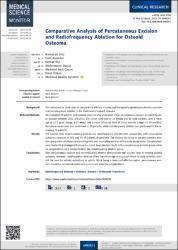| dc.contributor.author | Atiç, Ramazan | |
| dc.contributor.author | Alemdar, Celil | |
| dc.contributor.author | Elçi, Serhat | |
| dc.contributor.author | Dusak, Abdurrahim | |
| dc.contributor.author | Çaçan, Mehmet Akif | |
| dc.contributor.author | Özkul, Emin | |
| dc.contributor.author | Aytekin, Mahmut Nedim | |
| dc.date.accessioned | 2023-07-11T11:08:25Z | |
| dc.date.available | 2023-07-11T11:08:25Z | |
| dc.date.issued | 2023 | en_US |
| dc.identifier.citation | Atiç, R., Alemdar, C., Elçi, S., Dusak, A., Çaçan, M. A., Özkul, E. ... Aytekin, M. N. (2023). Comparative analysis of percutaneous excision and radiofrequency ablation for osteoid osteoma. Medical Science Monitor : International Medical Journal of Experimental and Clinical Research, 29, e940292-e940292. https://dx.doi.org/10.12659/MSM.940292 | en_US |
| dc.identifier.issn | 1234-1010 | |
| dc.identifier.issn | 1643-3750 | |
| dc.identifier.uri | https://dx.doi.org/10.12659/MSM.940292 | |
| dc.identifier.uri | https://hdl.handle.net/20.500.12511/11181 | |
| dc.description.abstract | BACKGROUND This retrospective study aims to compare the efficacy of computed tomography-guided percutaneous excision and radiofrequency ablation in the treatment of osteoid osteoma. MATERIAL AND METHODS We evaluated 40 patients with osteoid osteoma who underwent either percutaneous excision or radiofrequency ablation between 2012 and 2015. The cohort consisted of 10 female and 30 male patients, with a mean age of 15.1 years (range: 4-27 years) and a mean follow-up time of 19.02 months (range: 11-39 months). Percutaneous excision was performed in 20 patients, while radiofrequency ablation was performed in the remaining 20 patients. RESULTS The success rates of percutaneous excision and radiofrequency ablation were comparable, with unsuccessful outcomes observed in 10% and 5% of patients, respectively. The reasons for failure in the percutaneous excision group were attributed to a marking error and incomplete excision of the wide-based nidus. Complications were limited to pathological fracture (n=1) and deep infection (n=1) in the percutaneous excision group, while no complications were encountered in the radiofrequency ablation group. CONCLUSIONS Both percutaneous excision and radiofrequency ablation demonstrate high success rates in treating osteoid osteoma. However, radiofrequency ablation offers the advantage of a quicker return to daily activities without the need for activity restrictions or splints. While being a more cost-effective option, percutaneous excision should be considered cautiously to minimize potential complications. | en_US |
| dc.language.iso | eng | en_US |
| dc.publisher | NLM (Medline) | en_US |
| dc.rights | info:eu-repo/semantics/openAccess | en_US |
| dc.rights | Attribution-NonCommercial-NoDerivatives 4.0 International | * |
| dc.rights.uri | https://creativecommons.org/licenses/by-nc-nd/4.0/ | * |
| dc.subject | Radiofrequency Ablation | en_US |
| dc.subject | Osteoma, Osteoid | en_US |
| dc.subject | Orthopedic Procedures | en_US |
| dc.title | Comparative analysis of percutaneous excision and radiofrequency ablation for osteoid osteoma | en_US |
| dc.type | article | en_US |
| dc.relation.ispartof | Medical Science Monitor : International Medical Journal of Experimental and Clinical Research | en_US |
| dc.department | İstanbul Medipol Üniversitesi, Tıp Fakültesi, Cerrahi Tıp Bilimleri Bölümü, Ortopedi ve Travmatoloji Ana Bilim Dalı | en_US |
| dc.identifier.volume | 29 | en_US |
| dc.identifier.startpage | e940292 | en_US |
| dc.identifier.endpage | e940292 | en_US |
| dc.relation.publicationcategory | Makale - Uluslararası Hakemli Dergi - Kurum Öğretim Elemanı | en_US |
| dc.identifier.doi | 10.12659/MSM.940292 | en_US |
| dc.institutionauthor | Çaçan, Mehmet Akif | |
| dc.identifier.wosquality | Q3 | en_US |
| dc.identifier.wos | 001040497200001 | en_US |
| dc.identifier.scopus | 2-s2.0-85162749328 | en_US |
| dc.identifier.pmid | 37349982 | en_US |



















